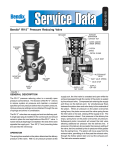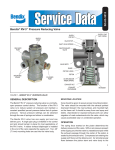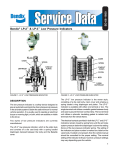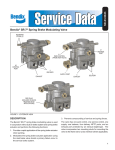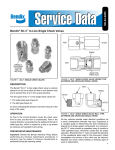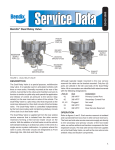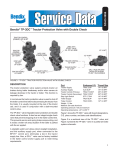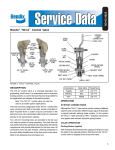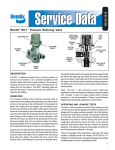Download BENDIX BW1588 User's Manual
Transcript
SD-03-3520 ® Bendix® RV-4™ Pressure Reducing Valve EXHAUST PASSAGE CONTROL PORT (PLUGGED) SUPPLY PORT EXHAUST CONTROL PISTON VALVE SPRING EXHAUST CONTROL PORT (PLUGGED) SUPPLY PORT DELIVERY PORT (2) MOUNTING HOLE (2) BALANCE PISTON DELIVERY (2) BALANCE PISTON SPRINGS SPRING SHIMS FIGURE 1 GENERAL DESCRIPTION The RV-4™ pressure reducing valve is a normally open pressure control device. The function of the RV-4™ valve is to reduce system air pressure and maintain a constant specified pre-set pressure below that of system pressure. Various pressure settings can be obtained through the use of springs and shims in combination. The RV-4™ valve has one supply port and two delivery ports. A single pipe plug is installed in the control port and should remain in place. OPERATION The spring force exerted on the balance piston determines the delivery pressure of the valve. With no air pressure present at the supply port, the inlet valve is unseated and open while the exhaust passage through the center of the control piston is sealed by the exhaust valve. Compressed air entering the supply port flows past the open inlet valve, around the balance piston and out the two delivery ports. When air pressure on the balance piston overcomes spring force, the piston moves and the valve spring forces the inlet valve on its seat, closing off the supply of air. The exhaust remains closed. If air pressure in the delivery line drops, spring force under the balance piston overcomes air pressure. Subsequent piston movement will unseat the inlet valve allowing additional air pressure into the delivery lines. If pressure in the delivery lines exceeds the pressure setting of the valve, the force exerted by the air pressure will be greater than the spring force. The balance piston will move away from the exhaust valve, permitting air to flow past the exhaust valve, through the hollow piston stem and out the exhaust port. The inlet valve will remain closed. 1 PREVENTIVE MAINTENANCE Important: Review the Bendix Warranty Policy before performing any intrusive maintenance procedures. A warranty may be voided if intrusive maintenance is performed during the warranty period. 4. No two vehicles operate under identical conditions, as a result, maintenance intervals may vary. Experience is a valuable guide in determining the best maintenance interval for air brake system components. At a minimum, the RV-4™ valve should be inspected every 6 months or 1500 operating hours, whichever comes first, for proper operation. Should the RV-4™ valve not meet the elements of the operational tests noted in this document, further investigation and service of the valve may be required. 5. OPERATING & LEAKAGE TESTS 7. 6. OPERATING Connect an accurate test gauge in the supply and delivery lines of the RV-4™ valve. Make certain that supply air pressure is at the vehicle manufacturers recommended level. Delivery pressure should be within plus or minus 5 p.s.i. of the delivery pressure specified for the RV-4™ valve. If not, the valve should be repaired or replaced. If the valve meets this operating test, proceed to the leakage tests. Do not remove the gauges at this time. 8. 9. LEAKAGE With supply pressure at the level recommended by the vehicle manufacturer, apply a soap solution to the 1/4" N.P.T. plug in the control port, around the supply port and to the exhaust. Leakage should not exceed a 1" diameter bubble in 3 seconds (175 SCCM). If leakage is excessive, the valve should be repaired or replaced and the operating and leakage tests performed at the time of repair or replacement. Proceed to the “Removal and Installation” instructions. This concludes the operation and leakage tests and the test gauges should be removed. WARNING! PLEASE READ AND FOLLOW THESE INSTRUCTIONS TO AVOID PERSONAL INJURY OR DEATH: When working on or around a vehicle, the following general precautions should be observed at all times. 1. Park the vehicle on a level surface, apply the parking brakes, and always block the wheels. Always wear safety glasses. 2. Stop the engine and remove ignition key when working under or around the vehicle. When working in the engine compartment, the engine should be shut off and the ignition key should be removed. Where circumstances require that the engine be in operation, EXTREME CAUTION should be used to prevent personal injury resulting from contact with moving, rotating, leaking, heated or electrically charged components. 3. Do not attempt to install, remove, disassemble or assemble a component until you have read and 2 10. thoroughly understand the recommended procedures. Use only the proper tools and observe all precautions pertaining to use of those tools. If the work is being performed on the vehicle’s air brake system, or any auxiliary pressurized air systems, make certain to drain the air pressure from all reservoirs before beginning ANY work on the vehicle. If the vehicle is equipped with an AD-IS™ air dryer system or a dryer reservoir module, be sure to drain the purge reservoir. Following the vehicle manufacturer’s recommended procedures, deactivate the electrical system in a manner that safely removes all electrical power from the vehicle. Never exceed manufacturer’s recommended pressures. Never connect or disconnect a hose or line containing pressure; it may whip. Never remove a component or plug unless you are certain all system pressure has been depleted. Use only genuine Bendix® replacement parts, components and kits. Replacement hardware, tubing, hose, fittings, etc. must be of equivalent size, type and strength as original equipment and be designed specifically for such applications and systems. Components with stripped threads or damaged parts should be replaced rather than repaired. Do not attempt repairs requiring machining or welding unless specifically stated and approved by the vehicle and component manufacturer. Prior to returning the vehicle to service, make certain all components and systems are restored to their proper operating condition. REMOVAL & INSTALLATION REMOVAL 1. Hold the vehicle on a level surface by means other than the air brakes. 2. Remove all air pressure from all reservoirs. 3. Identify, mark and then disconnect all air lines attached to the valve. 4. Remove the valve. INSTALLATION 1. Inspect and clean all air lines that connect to the valve. 2. Clean the vehicle valve mounting area and mount the valve. 3. Reconnect the air lines according to the identification marks made during removal. DISASSEMBLY (Refer to Figure 2) 1. Remove exhaust cover screw (1), exhaust cover (2), and exhaust diaphragm (3). 2. Remove four cap screws (4) with lockwashers (5) and cover (6). 3. Remove control piston (7). 1 7 2 3 6 4 5 26 10 8 SUPPLY PORT 3/8” P.T. 9 12 & 13 25 27 11 14 SECTION VIEW OF SUPPLY PORT 15 16 23 24 22 21 20 18 17 19 Key No. 1 Description Screw Key No. 10 Description Retaining Ring Key No. 19 Description Cover 2 3 Cover Exhaust Diaphragm 11 12 O-Ring Retainer O-Ring 20 21 Shims Inner Spring 4 5 Cap Screw Lock Washer 13 14 O-Ring Spring 22 23 Outer Spring Balance Piston 6 7 Cover Control Piston 15 16 Spring Seat Valve Body 24 25 O-Ring Retaining Ring 8 9 Retaining Ring Inlet/Exhaust Assy. 17 18 Cap Screws Lockwashers 26 27 Supply Adapter O-Ring FIGURE 2 4. Remove large retaining ring from body (8) and remove inlet/exhaust valve assembly (9). 5. Remove retaining ring from inlet/exhaust valve assembly. Remove o-ring retainer (11), remove inner and outer o-rings (12 & 13) from retainer. Remove spring (14) and spring seat (15) from valve body (16). 6. Remove four cap screws (17) with lockwashers (18) from opposite end and remove cover (19). 7. Remove shims (20) and inner (21) and outer (22) springs. 8. Remove balance piston (23). Remove o-ring (24) from balance piston. 9. Remove retaining ring (25) from supply port. Remove supply adapter (26). Remove o-ring (27) from supply adapter. ASSEMBLY (REFER TO FIGURE 2) Before assembly, lightly lubricate all o-rings, bores and mating surfaces with (Bendix Pc. No. 291126) Dow Coming 55-M pneumatic grease or equivalent. 1. Install o-ring (27) on supply adapter (26), place into supply port and install retaining ring (25). 2. Install o-ring (24) on balance piston (23), place piston into body. 3. Install inner (21) and outer (22) springs into base of balance piston and place shims (20) on top of springs. 4. Replace cover (19) and attach with four cap screws (17) with lockwashers (18). Torque to approximately 45 in. lbs. 5. Install spring seat (15) and spring (14) onto inlet/exhaust valve body (9). Install o-rings (12 & 13) onto o-ring retainer (11) and place on top of spring (14), compress and install retaining ring (10). 6. Install inlet/exhaust assembly (9) into valve body and install retaining ring (8). 7. Install control piston (7) into valve body. 8. Replace cover (6) and attach with four cap screws (4) and lockwashers (5). Torque to approximately 100 in. lbs. 9. Install exhaust diaphragm (3) and exhaust cover (2) on to valve cover (6) and attach with screw (1). TESTING REBUILT RV-4™ PRESSURE REDUCING VALVE Perform operating and leakage tests as outlined. 3 4 BW1588 © 2004 Bendix Commercial Vehicle Systems LLC. All rights reserved. 4/2004 Printed in U.S.A.




